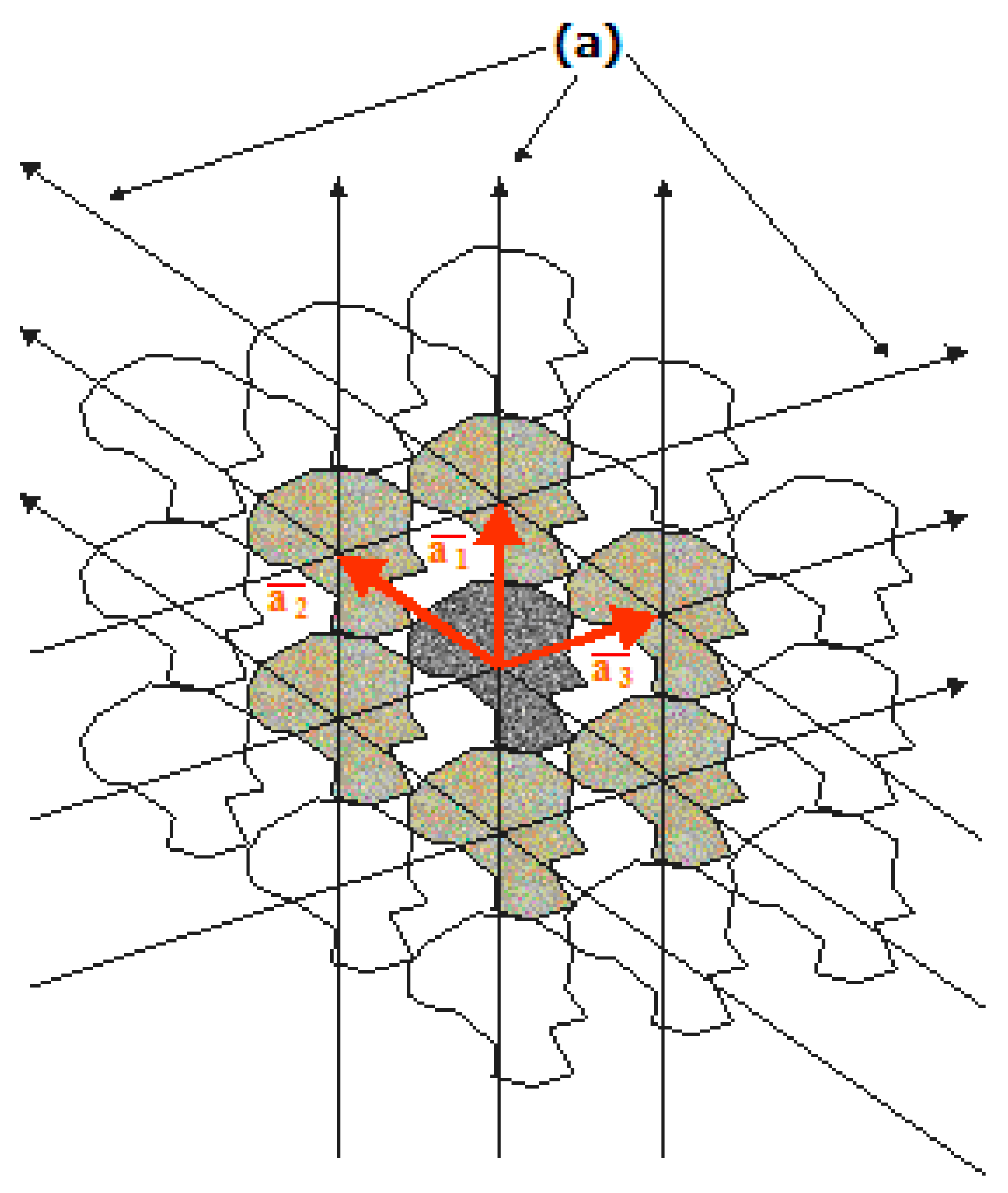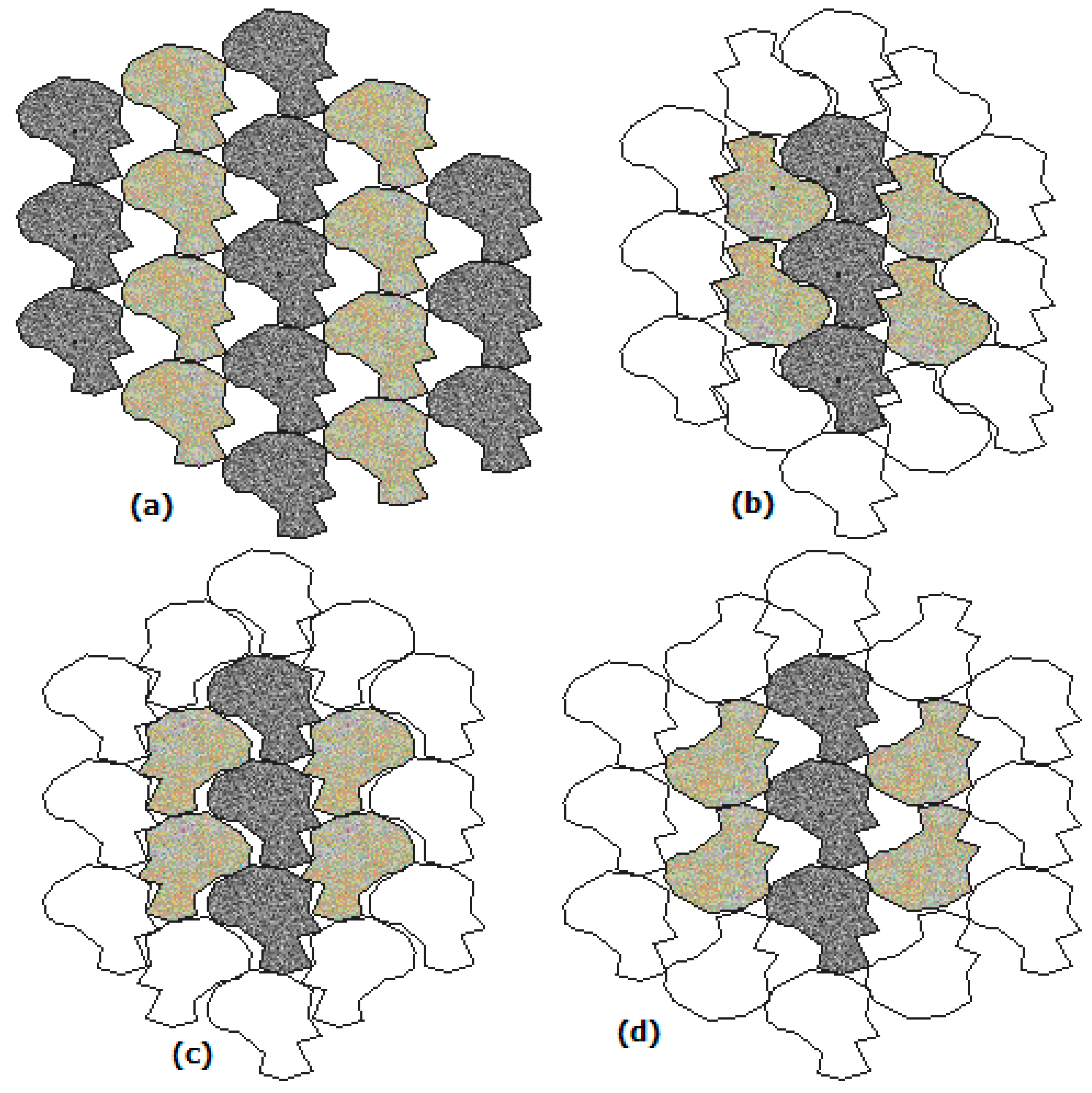Regular Two-Dimensional Packing of Congruent Objects: Cognitive Analysis of Honeycomb Constructions
Abstract
:Featured Application
Abstract
1. Introduction
- The points of intersection of an arbitrary straight line passing through the pole of the object (Figure 6a) with the hodograph (type_0) are fixed as two poles of future objects and centers of future hodographs (type_0);
- The points of intersection of the two new hodographs (type_0) with the already existing hodograph (type_0) are fixed as the four poles of future objects (Figure 6b);
- The obtained six poles make it possible to form a honeycomb construction (Figure 6c).
- The points of intersection of an arbitrary straight line passing through the pole of the object (Figure 7a) with the hodograph (type_0) are fixed as two poles of future objects and centers of future hodographs (type_1);
- The points of intersection of the two new hodographs (type_1) and the hodograph (type_1) centered at the pole of the object are fixed as four poles of future objects (Figure 7b);
- The obtained six poles make it possible to form a honeycomb construction (Figure 7c).
2. Methodology
- Select an arbitrary point within an object (an arbitrary polygon). This point will be the pole of the object;
- Select the type of congruent relationship you want;
- Convert the original object by the type of congruent relationship you want;
- Create a hodograph for congruently oriented initial objects;
- Create a hodograph for objects of the selected congruent relationship;
- Form a honeycomb construction of regular packing of objects of the selected type of congruent relationship using the created hodographs;
- Connect the poles of seven objects of the formed honeycomb constructionwith straight lines, thereby creating a hexagon of poles;
- Combining the poles of seven objects of a honeycomb construction by straight lines divides the central object into six fragments, each of which is duplicated twice by fragments cut off from six external objects;
- Fill fragments of each of the six groups of identical fragments with their own color.
3. The Analysis of Honeycomb Constructions of Regular Packings of Congruent Objects
3.1. Regular Packing of Congruent Oriented Objects (Type_0)
Optimization of Regular Packing of Congruent Oriented Objects (Type_0)
3.2. Regular Packing of Congruent GOs (Type_1, Type_2, Type_3)
- Leads to the second heuristic judgment: “inside the hexagon of poles three GOs are placed”;
- Shows the identity of triangles I and V, as well as triangles II and IV.
3.3. Some Considerations about Lattices Packing of Congruent Objects
4. Discussion
- For type_1 and type_2, in the left and right halves of the pole hexagon there are similar sets of fragments;
- For type_0 and type_3 there is no similar placement of fragments.
- Formation of cellular structures of regular packages of congruent GOs with the help of FTA hodograph. GOs can be both convex and non-convex polygons;
- Application of the proposed cognitive model for analysis of cellular structures of regular congruent GO packings.
5. Conclusions
- Regular packings of congruent GOs have a honeycomb structure, that is, any GO of a regular packing touches six surrounding GOs;
- Inside the hexagon poles of the cell design there are fragments of three GOs;
- The density of coverage of the plane by regular packing of congruent GOs is determined by the density of the coating hexagon poles of the packing and is equal to the ratio of the three squares of GO to the square of hexagon poles;
- To describe the regular packing of congruent GO’s, triple-lattice packing is suggested;
- Any partition of the plane into regions of equal area has a perimeter at least that of the affine-regular hexagonal honeycomb tiling.
Author Contributions
Funding
Acknowledgments
Conflicts of Interest
References
- Dyckhoff, H.A. A typology of cutting and packing problems. Eur. J. Oper. Res. 1990, 44, 145–159. [Google Scholar] [CrossRef]
- Wascher, G.; Hausser, H.; Schumann, H. An improved typology of cutting and packing problems. Eur. J. Oper. Res. 2007, 183, 1109–1130. [Google Scholar] [CrossRef]
- Stoyan, Y.G.; Panasenko, A.A. Periodic Placement of Geometric Objects; Naukova Dumka: Kiev, Ukraine, 1978; 176p. (In Russian) [Google Scholar]
- Martinov, V.V.; Babel, A.V. A method for placing planar geometry regularly based on geometric transformations. Bull. Ufa State Aviat. Tech. Univ. 2013, 17, 208–214. (In Russian) [Google Scholar]
- Zabelin, S.L.; Frolovsky, V.D. Development and models research, methods and algorithms for synthesis and problem solving analysis of the geometric coverage. Sibguti Bull. 2013, 2, 42–53. (In Russian) [Google Scholar]
- Rogers, C.A. Packing and Covering; Cambridge University Press: Cambridge, UK, 1964; 109p. [Google Scholar]
- Cassels, J.W.S. An Inroduction to the Geometry of Umbers; Springer: Berlin/Gottingen/Heidelberg, Germany, 1959. [Google Scholar]
- Toth, L.F. Lagerungen in der Ebene, auf der Kugel und imRaum; Springer: Berlin/Gottingen/Heidelberg, Germany, 1953. [Google Scholar]
- Stoyan, Y.G.; Pankratov, A.V. Regular packing of congruent polygons on the rectangular sheet. Eur. J. Oper. Res. 1999, 113, 653–675. [Google Scholar] [CrossRef]
- Kallus, Y.; Kusner, W. The local optimality of the double lattice packing. Discret. Comput. Geom. 2018, 56, 449–471. [Google Scholar] [CrossRef] [Green Version]
- Jiao, Y.; Stillinger, F.H.; Torquato, S. Optimal Packing of Superdisks and the Role of Symmetry. Phys. Rev. Lett. 2008, 100, 245–504. [Google Scholar] [CrossRef] [Green Version]
- Klevanskiy, N.N. Regular plane arrangement of arbitrary figures: Cognitive visualization. J. Adv. Res. Tech. Sci. 2017, 30–33. (In Russian) [Google Scholar]
- Kuperberg, G.; Kuperberg, W. Double-lattice packings of convex bodies in the plane. Discret. Comput. Geom. 1990, 5, 389–397. [Google Scholar] [CrossRef]
- Hales, T.C. The honeycomb conjecture. Discret. Comput. Geom. 2001, 25, 1–22. [Google Scholar] [CrossRef] [Green Version]
- Zenkin, A.A. Cognitive Computer Graphics; Nauka: Moscow, Russia, 1991; 192p. (In Russian) [Google Scholar]
- Klevanskiy, N.N.; Antipov, M.A.; Krasnikov, A.A. Cognitive Aspects of Timetable Visualization: Support Decision Making. Procedia Comput. Sci. 2017, 103, 94–99. [Google Scholar] [CrossRef]
- Hestenes, D. Notes for a modeling theory of science, cognition and instruction. In Proceedings of the 2006 GIREP Conference, Amsterdam, The Netherlands, 20–25 August 2006. [Google Scholar]
- Hohol, M.; Milkowski, M. Cognitive Artifacts for Geometric Reasoning. Found. Sci. 2019, 24, 657–680. [Google Scholar]
- Kriegeskorte, N.; Kievit, R.A. Representational geometry: Integrating cognition, computation, and the brain. Trends Cogn. Sci. 2013, 17, 401–412. [Google Scholar] [CrossRef] [PubMed] [Green Version]














| Type of Congruent Relation | Square of Hexagon Pole | Dense Factor % |
|---|---|---|
| Type_0 | 88,405.5 | 75.4 |
| Type_1 | 65,274.5 | 94.55 |
| Type_2 | 66,506.5 | 92.97 |
| Type_3 | 82,797 | 72.2 |
Publisher’s Note: MDPI stays neutral with regard to jurisdictional claims in published maps and institutional affiliations. |
© 2021 by the authors. Licensee MDPI, Basel, Switzerland. This article is an open access article distributed under the terms and conditions of the Creative Commons Attribution (CC BY) license (https://creativecommons.org/licenses/by/4.0/).
Share and Cite
Klevanskiy, N.N.; Tkachev, S.I.; Voloshchuk, L.A.; Nourgaziev, R.B.; Mavzovin, V.S. Regular Two-Dimensional Packing of Congruent Objects: Cognitive Analysis of Honeycomb Constructions. Appl. Sci. 2021, 11, 5128. https://doi.org/10.3390/app11115128
Klevanskiy NN, Tkachev SI, Voloshchuk LA, Nourgaziev RB, Mavzovin VS. Regular Two-Dimensional Packing of Congruent Objects: Cognitive Analysis of Honeycomb Constructions. Applied Sciences. 2021; 11(11):5128. https://doi.org/10.3390/app11115128
Chicago/Turabian StyleKlevanskiy, Nikolay N., Sergey I. Tkachev, Ludmila A. Voloshchuk, Rouslan B. Nourgaziev, and Vladimir S. Mavzovin. 2021. "Regular Two-Dimensional Packing of Congruent Objects: Cognitive Analysis of Honeycomb Constructions" Applied Sciences 11, no. 11: 5128. https://doi.org/10.3390/app11115128







